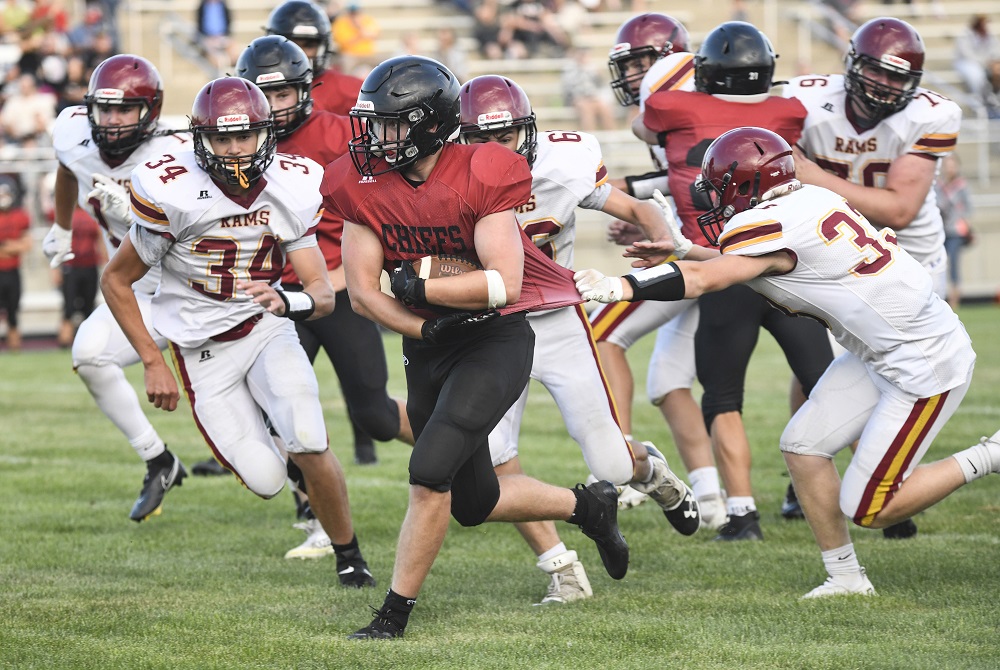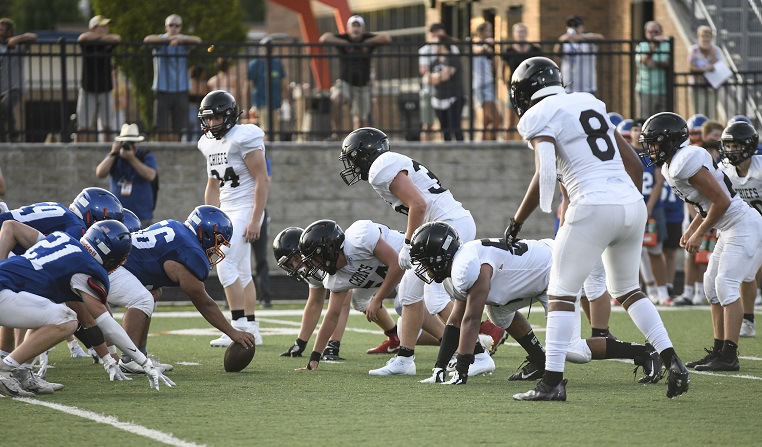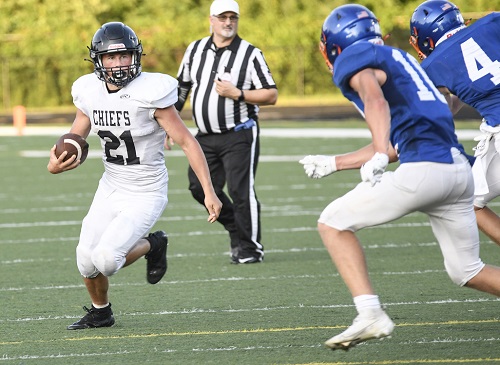
Haslett Saving Big Hits for Game Time
August 16, 2016
By Geoff Kimmerly
Second Half editor
HASLETT – The sound of cleats on pavement. He and his teammates, hand in hand, walking toward the field together minutes before kickoff. Manowar’s “Heart of Steel” ringing in their ears from a few minutes before.
 Justin Kuchnicki gave himself goose bumps Monday describing Haslett’s weekly pregame ritual, which the senior lineman will take part in again beginning Aug. 26 when the Vikings open this season against Remus Chippewa Hills.
Justin Kuchnicki gave himself goose bumps Monday describing Haslett’s weekly pregame ritual, which the senior lineman will take part in again beginning Aug. 26 when the Vikings open this season against Remus Chippewa Hills.
They’ll certainly be revved up – and especially to lay some big hits after saving them up during three weeks of non-collision practices.
Haslett has one of the most successful football programs in the Lansing area, with two trips to MHSAA championship games and 14 playoff appearances total over the last 18 seasons. The Vikings finished 6-4 a year ago against a schedule featuring four eventual playoff teams.
The program also might be the first in all of Michigan high school football to fully eliminate full-speed hitting at practice, something Haslett has moved toward over the last few seasons before longtime coach Charlie Otlewski decided to knock it out of his practice plans completely this fall in large part to keep his players healthier for when it matters most.
“It gives you the edge when it gets to game day. You practice all week and you’re not really hitting or doing anything like that, and you get to game day … and everyone’s ready to just go out there and fly around and make plays,” Kuchnicki said. “You’re not really worried about kinks and stuff in your body that you’d have from practices, so you just go out there and lay it on the line.”
Friday was the first day Michigan high school players were allowed to practice in full pads. Storms drenched mid-Michigan that afternoon, so Haslett’s first day in full gear was Monday. And from a distance, it sounded like any other full-contact practice with the normal hoots and hollers and smacking of pads.
But on closer look, it was anything but. Lineman worked against blocking dummies on a sled or teammates holding hand pads. When the offense came together to run plays, linemen blocked against overturned plastic trash barrels. On the opposite end of the field, subvarsity players worked on defensive pursuit angles but again without hitting. Under a set of uprights laid an old gymnastics mat used to soften the fall during tackling drills, which players again did against standup dummies instead of their teammates.
Reducing collisions – that is, live, game-speed, player-vs.-player hitting – remains the focus of most conversations on health and safety in football. Much of the discussion is centered on reducing concussions, and MHSAA rules changes that took effect beginning with the 2014 season limit teams to one practice per day during the preseason (when teams frequently practice twice) where collisions can take place. During the regular season, teams can have collisions during practice only two days per week.
 Otlewski – who formerly coached St. Ignace from 1990-93 before taking over at Haslett in 1994 – said his practices used to follow what could be considered a traditional after-school plan: individual position drills for an hour or more followed by 11-on-11 full contact team practice for 30-40 minutes, twice a week.
Otlewski – who formerly coached St. Ignace from 1990-93 before taking over at Haslett in 1994 – said his practices used to follow what could be considered a traditional after-school plan: individual position drills for an hour or more followed by 11-on-11 full contact team practice for 30-40 minutes, twice a week.
But a handful of reasons, chiefly the desire to avoid injuries, started his program on a different path five years ago.
“Nobody wants injuries, but you surely don’t want them in practice. Then the concussion thing started to happen. (But) we didn’t do it because of concussions; we did it because of general overall injuries,” Otlewski said.
“If we lose a guy in Thursday’s scrimmage, or next Thursday in a game, OK, that’s football. But what we don’t want to do is lose someone in practice, because that seems unnecessary.”
The initial changes Haslett began to make to practices that fall of 2011 became drastic two years later, when he and his staff went to a different practice model completely. The Vikings now break every practice into 10-minute sessions alternating between team time and position drills, so position coaches can work with players individually before and after seeing how they perform when all 11 are running plays together.
This new breakdown brought the amount of player-on-player contact at practice down significantly as much more time was dedicated to learning proper footwork, blocking and tackling techniques and other fundamentals. Players on Monday worked at 50-percent speed, at most, against teammates either in front of them and also not moving at game speed, or against others holding pads and dummies.
The last two seasons, the only full-contact session during practices came during preparation for goalline situations; Otlewski and his staff decided to eliminate those this fall as well.
“We’re OK with a certain level (of contact). But we never want to go on the ground; we always want to stay up,” he said. “We want to go fast enough so where we have to use the perfect technique to get there footwork-wise. But we’re trying to eliminate the physicality part.”
To be clear, eliminating all collisions/contact is not required by the MHSAA. And there are probably more than a few in the coaching fraternity who would think Haslett is making a massive mistake.
But the Vikings’ no-contact strategy follows a way of thinking made popular in part by coaches like Dartmouth College’s Buddy Teevens, whose team hasn’t tackled during practices in six years. The Ivy League as a whole adopted a policy of no tackling in practice for the regular season beginning this fall.
 Otlewski said teaching to tackle without contact allows his players to practice the same technique-building drills during four-player offseason workouts, his team’s no-pads summer camp and then while wearing pads during the season. His defense doesn’t face a live offense during the week, but he doesn’t think his players lose out because they can gain just as much from watching film and working on pursuit angles and recognizing formations. Same goes for his offense, which can still practice skill work and the passing game full-speed while lineman go half-speed working on footwork and blocking technique.
Otlewski said teaching to tackle without contact allows his players to practice the same technique-building drills during four-player offseason workouts, his team’s no-pads summer camp and then while wearing pads during the season. His defense doesn’t face a live offense during the week, but he doesn’t think his players lose out because they can gain just as much from watching film and working on pursuit angles and recognizing formations. Same goes for his offense, which can still practice skill work and the passing game full-speed while lineman go half-speed working on footwork and blocking technique.
And he sees 37 players on his varsity roster, with that total remaining consistent over the last many seasons – while three opponents on this year’s schedule don’t have junior varsities and a fourth won’t field a freshman team.
His players three seasons ago didn’t really like the idea of not hitting in practice at first. But they’ve since bought in. He hasn’t heard a ton from parents either way; but he taught a class on football for local moms over the winter, and they seemed to like the idea as well.
“On one hand, I’m a little apprehensive,” Otlewski said. “OK, we haven’t gone full go. Is there a difference all of a sudden when it’s live Thursday against (Grand Rapids) Christian? Are we going to be up to speed?
“I think I still worry about that a little bit. But once we get into it, it’s fine.”
Kuchnicki is just as confident. Contact doesn’t bother this guy. He’s 6-foot-6 and in the neighborhood of 320 pounds. Sure, he’d love to have one contact practice this year so he and his teammates can back up some of the trash-talking they do to each other on the field.
But he’s fine with saving his biggest hits for opponents – and especially those who might think Haslett won’t be prepared for a physical game.
“They’d probably think we’re soft,” Kuchnicki said. “But when it comes game day, they change their minds instantly. I’ll tell you that.”
 Geoff Kimmerly joined the MHSAA as its Media & Content Coordinator in Sept. 2011 after 12 years as Prep Sports Editor of the Lansing State Journal. He has served as Editor of Second Half since its creation in Jan. 2012. Contact him at [email protected] with story ideas for the Barry, Eaton, Ingham, Livingston, Ionia, Clinton, Shiawassee, Gratiot, Isabella, Clare and Montcalm counties.
Geoff Kimmerly joined the MHSAA as its Media & Content Coordinator in Sept. 2011 after 12 years as Prep Sports Editor of the Lansing State Journal. He has served as Editor of Second Half since its creation in Jan. 2012. Contact him at [email protected] with story ideas for the Barry, Eaton, Ingham, Livingston, Ionia, Clinton, Shiawassee, Gratiot, Isabella, Clare and Montcalm counties.
PHOTOS: (Top) Haslett lineman work on blocking during Monday's practice. (Middle) Vikings coach Charlie Otlewski instructs his players on one of the team's blocking schemes. (Below) Backs work on the option with barrels serving as the defensive front.

Grinding Ground Game Has White Pigeon Eyeing Memorable Run
By
Wes Morgan
Special for MHSAA.com
September 8, 2021
With just a cursory glance at the 2020 results for the White Pigeon varsity football team, the Chiefs’ 4-3 record might not seem all that impressive.
 Their opponents this year, however, know not to discount a program that has the potential to both reshape the Southwest 10 Conference standings by the end of the fall, but also to shake things up once the Michigan High School Athletic Association Division 8 playoffs get rolling.
Their opponents this year, however, know not to discount a program that has the potential to both reshape the Southwest 10 Conference standings by the end of the fall, but also to shake things up once the Michigan High School Athletic Association Division 8 playoffs get rolling.
Losing two of those contests to eventual D8 champion Centreville — a 14-8 defeat in Week 2 and a 16-0 loss in the District championship game — White Pigeon’s only other misstep was a 26-24 loss to Mendon in what was the Hornets’ final season before moving to the 8-player ranks. White Pigeon’s District opener win over Saugatuck was the school’s first postseason victory since 2009.
The Chiefs are rolling so far this year with sizable wins over Saugatuck (48-6) and Galesburg-Augusta (38-7) to set up a conference opener this Friday against Decatur (1-1). Comstock is White Pigeon’s Week 4 opponent before the anticipated matchup with Centreville on Sept. 24.
"It definitely was a misleading (record) last year,” fourth-year head coach Shawn Strawser said. “(Centreville) was just a little better than us and ended up being state champs. Knowing that we were right there and that’s how close we could have been to having a nice run and being one of the better teams in the state … we watched those teams play and there wasn’t anybody that scared us. We would have loved to have chances against some of those schools last year.
 "I think our guys seeing a team from our conference won a state title, it gives them some confidence that they can do that too if they work hard.”
"I think our guys seeing a team from our conference won a state title, it gives them some confidence that they can do that too if they work hard.”
Perhaps that wish will come true this year as Strawser’s Wing-T offense is pounding opposing defenses thus far despite the graduation of 12 seniors, only 17 players on the varsity roster and several underclassmen in starting roles. If so, it will be because of heart and not size.
At a preseason scrimmage, Strawser instituted a new rule as a result.
"The boys come walking down the sideline and they don’t have their pads on,” he said. “I said, ‘Dang it; what are you guys doing? Don’t you ever walk out here with your pads off. We ain’t intimidating nobody with our pads off, so go get them back on. Some people might see us with our pads off and they think we’re a JV team. But I’ll tell you what, we don’t play like a JV team.”
Seniors Jack Davidson and Dylan Carper so far have amassed staggering rushing production for the Chiefs, who have thrown the ball just three times. Davidson, a 5-foot-10, 170-pound fullback, ran for 299 yards and three touchdowns against Saugatuck and he added 137 yards and three more TDs vs. the Rams in Week 2. Carper, a 5-9, 165-pound back, piled up 130 yards and two scores in Week 1 and added 99 yards and a pair of touchdowns last week. The two also line up at linebacker — a position of strength for the White Pigeon defense
"Carper is a football player,” Strawser said. “You can play him anywhere. He’s the hardest hitter on the team. He could have had 300 yards the first night had I been giving him the ball more. Jack Davidson is not the type of fullback we had the first couple years. He sees holes really well and is a really strong runner.”
Of course, success begins up front with junior tight ends Jordan Stamper and Chris Jackson, left tackle Chaz Underwood (freshman), left guard Esteban Castro (junior), center Wyatt Carunchia (junior), right guard Luke Gropp (senior) and right tackle Seth Miller (sophomore).
 "Our line has probably been the best it has been in a few years, so that’s a big reason why we get so many yards per carry and so many touchdowns,” Carper said. “Them doing their job consistently helps us a lot. It makes it really easy for us to just run through the big hole they made.
"Our line has probably been the best it has been in a few years, so that’s a big reason why we get so many yards per carry and so many touchdowns,” Carper said. “Them doing their job consistently helps us a lot. It makes it really easy for us to just run through the big hole they made.
"It’s really fun watching Jack go for all these yards. And then the next thing you know, I get to carry and go for a big touchdown. We just get to go back and forth with each other. It’s fun to play and fun to watch. I’m faster than Jack, so I hit the hole quicker. But he’s more powerful and patient than I am. He waits for the hole to develop while I go right through it.”
Davidson has a unique perspective on how the front seven should operate having spent last season at left guard to shore up the offensive line.
"Yeah, I got yelled at a few times,” Davidson joked. “It made me understand how tough it is. I get now why they ask a lot of questions and that I have to be more patient in the backfield.”
"We knew it was going to be a one-year deal,” Strawser added of Davidson’s line days. “We were a little thin on the line last year and he stepped up and did a nice job. But we knew he’d be moving back this year.”
With the meat of the schedule ahead, the Chiefs believe they have what it takes to get to the next level.
"I just think we work really good as a team. And with us all working together, I think we can cause them some trouble,” Carper said. “Every year I think we’re in the mix for (a conference championship), but this year there is a good team at Centreville and at Comstock, so it should be a close race.”
 Wes Morgan has reported for the Kalamazoo Gazette, ESPN and ESPNChicago.com, 247Sports and Blue & Gold Illustrated over the last 12 years and is the publisher of JoeInsider.com. He can be reached at [email protected] with story ideas for Berrien, Cass, St. Joseph and Branch counties.
Wes Morgan has reported for the Kalamazoo Gazette, ESPN and ESPNChicago.com, 247Sports and Blue & Gold Illustrated over the last 12 years and is the publisher of JoeInsider.com. He can be reached at [email protected] with story ideas for Berrien, Cass, St. Joseph and Branch counties.
PHOTOS: (Top) White Pigeon’s Jack Davidson pulls away from a potential tackler last week against Galesburg-Augusta. (Middle) White Pigeon’s defensive front seven – including Davidson (30), Luke Gropp (54), Chris Jackson (8) and Jordan Stamper (84) – loads the box against Saugatuck during Week 1. (Below) Dylan Carper (21) gets to the edge against Saugatuck. (Photos courtesy of the White Pigeon football program.)

